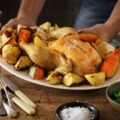Roast Beef – Alison McKee
It can be daunting, even for experienced cooks, to ‘turn out’ the perfect Roast Beef as everyone has an  opinion on the correct degree of ‘doneness.’ I like my beef to be rare – medium rare but often my guests like their beef to be medium – well-done. No-one, in my opinion, likes to see meat swimming in a pool of red juices!
opinion on the correct degree of ‘doneness.’ I like my beef to be rare – medium rare but often my guests like their beef to be medium – well-done. No-one, in my opinion, likes to see meat swimming in a pool of red juices!
The secret is of course to rest the meat for approximately 5 minutes for every 500g meat before carving and serving. Resting enables the temperature of the meat to even out causing the meat fibres to relax and reabsorb some of the juices. Remember that the internal temperature will continue to rise after the meat is removed from the oven and during the resting time. So you need to allow for a ‘carry-over’ cooking time.
The cuts of beef most suited to roasting at a high temperature, 200° C, are fillet (tenderloin), rib-eye (scotch fillet), standing rib, wing rib, sirloin (porterhouse), and rump. Before cooking the meat should always be brought to room temperature and the oven preheated. Trim the excess fat and silverskin if necessary. Tie the beef with cooking string to help maintain the shape during the cooking process. After seasoning brown the meat in a medium hot pan before placing the meat on a rack to roast. A rack allows even heat circulation and browning. The degree of ‘doneness’ can be judged by touch – soft and springy (rare), slightly firmer (medium), firm (well done), by sight – testing the colour of the meat juices or by using a meat thermometer – 60°c is medium rare. Remove the string after resting and before carving.
A roast of beef is, for me, a celebration and would not be complete without Yorkshire pudding. Yorkshire pudding or ‘dripping/ batter pudding’ dates from the mid-eighteenth century. Hannah Glasse’s The Art of Cookery made Plain and Easy 1747 is cited as containing the first known recipe. Traditionally Yorkshire pudding composes of egg, flour, and milk, mixed to a batter then rested and cooked in a large shallow tin under the roasting meat containing a layer of very hot beef dripping that enables the pudding to puff. Strictly speaking the pudding should be cut into squares and served with gravy before the meat, to take the edge off the appetite. Left over Yorkshire pudding was served cold, as a treat for children, sprinkled with sugar or drizzled with golden syrup.
Like all recipes Yorkshire pudding as evolved over time. Today Yorkshire pudding is most often baked in muffin tins, similar to the American version of popovers, and served alongside the roasted beef with gravy. Modern interpretations include baking in dariole moulds, adding sun dried tomatoes, black olives, grainy mustard, pesto or fresh herbs to the batter, and of course, Nigella Lawson’s Yorkshire pudding served as dessert with Golden Syrup and pouring cream. My favourite variation on this classic dish is, however, ‘Toad in the Hole’ – sausages in Yorkshire pudding batter with gravy and pea puree!
Yorkshire Pudding.
1 heaped breakfast cup flour 1 pint milk, good measure ½ teaspoon salt 3 eggs 1 tablespoon dripping
Sift flour into a basin, sprinkle salt over it, and make a hole in the middle. Break each egg separately, and stir gradually in, add sufficient milk with wooden spoon until thick batter, then add and mix remainder of milk, and allow the batter to stand for half-an-hour. Place the dripping into a baking dish, make quite hot, and pour in batter; bake slowly for half-hour.
A layer of raisins put in bottom of tin before pouring in batter makes a nice raisin. Batter Pudding; try this. (quoted from The ‘Sure to Rise’ Cookery Book T. J. Edmonds, 1914.)
Pea Puree or Squishy Peas
2 cups frozen peas
Chicken stock or water
1 tbsp butter
Cream (optional)
Cook the peas in chicken stock or water until tender. Drain into a bowl reserving the liquid.
Either: Add the butter to the peas and roughly mash with a potato masher.
Add the cooking liquid back to the peas spoonful by spoonful, beating with a wooden spoon until the peas have absorbed enough liquid to be moist and squishy.
Or: Combine the peas and butter with 2 tbsp of the cooking liquid in a blender. Blend until pureed adding additional cream or stock to reach the desired consistency.




what size dariol mould would you use for yorkshire puddings
excellent issues altogether, you just gained a new reader. What might you recommend about your post that you made some days ago? Any positive?
Thanks , I have recently been searching for info approximately this subject for a long time and yours is the best I have came upon till now. But, what concerning the conclusion? Are you positive about the source?|What i do not understood is actually how you’re now not actually a lot more smartly-liked than you may be now. You are so intelligent.
I love a full roast dinner. I probably cook one once a year. My friends will queue up for it. However mine is not a touch on my Gran’s. I am not sure what was hotter the roast, the oven or the plates.
I mix the batter in a blender and I them let it stand (in the blender) in the fridge and let it get very cold. Make sure the lard (only time I ever would use lard) is smoking hot, give the bater a quick blits again and tip it at arms length into the pan and get the mixture back into the oven asap.
Apologies for the delay in replying.
This recipe is the original version from The ‘Sure to Rise’ Cookery Book by T. J. Edmonds, 1914!
And I totally agree the recipes from that era were quite vague.
These days I cook my Yorkshire Puddings at 210°C.
Can I ask what temp you cook your Yoprkshire puddings ar please, quite hot is a bit too vague – Ta